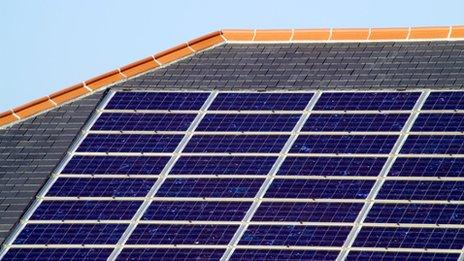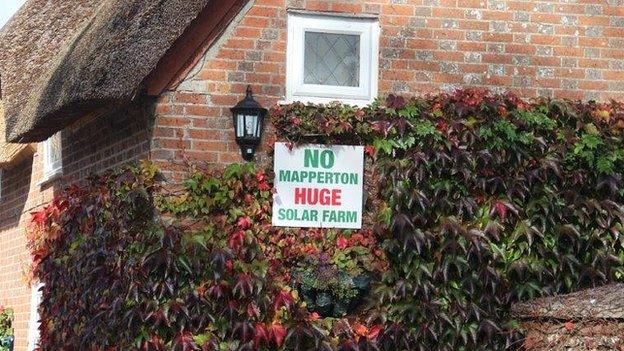Grid capacity worries spark UK solar farm boom
- Published

The government sees photovoltaic power as key to reaching renewables targets
Developers are racing to install large-scale solar parks on land across the UK in unprecedented numbers.
The rush has been sparked by concerns that Britain's ageing electrical grid has limited capacity for renewable energy.
Environmental campaigners are concerned by the size of the solar farms being proposed.
They argue that using agricultural land for energy production is swapping one form of dependency for another.
Harvesting the sun
Britain is not known for its sunny weather, so the idea of a boom in solar energy might seem ironic to some.
But the government sees photovoltaic power as a key element , externalin reaching renewables targets for 2020.
In its recently published roadmap it urges an eight-fold increase in solar power over the next seven years.
The price of PV panels dropped by 50% between 2010 and 2012, according to the Department for Energy and Climate Change (Decc).
Coupled with green subsidies that give a guaranteed rate of return over 20 years, farmers in the sunnier parts of the UK have been increasingly interested in raising silicon arrays, rather than crops or livestock.
Some critics of the government say the growing interest in all things solar is because voters are less likely to object, external to PV panels than they are to wind turbines or alternative sources of energy such as shale gas.
Counties like Dorset, Devon and Cornwall have seen large numbers of applicants for bigger solar installations over the past 12 months.
"This area is being bombarded with them," said Penny Mills from the Campaign to Protect Rural England.
"Instead of the odd acre, we are now getting these big schemes coming in for a hundred acres at a time. It is dramatically industrialising our countryside."
The boom is also being felt in nearby Dorset. Plans for 14 large-scale solar parks have been submitted, and, according to the CPRE, the majority of these are on farmland
"Nine of these sites were identified as farms," said Dr David Peacock, a local campaigner.
"It is taking land out of production for food, it is a change of use."
The campaigners argue that it is the nature of government subsidies that is driving the solar expansion. Farmers can make an excellent return by harvesting the sun instead of crops, thanks to the green levies that are paid by consumers through their bills.

Some campaigners are concerned by the use of agricultural land for solar farms
"It is a lot of money we are talking about," said Penny Mills from CPRE.
"For a 5MW scheme you want forty acres and the developer will pay you £40,000 a year for a forty acre plot. You can't blame the farmer, it is the government who are driving it."
Developers acknowledge there has been a rapid rise in applications in the last 12 months. Lightsource Renewable Energy operate some of the biggest solar PV plants in Britain.
But according to a spokesperson, the boom is not down to subsidies which are set to decline over the next three years. Instead the race has been started by the need for access to the electrical grid.
"The only constraint at the moment is grid availability," she said.
"The incentive for a developer to get their application as quick as possible is to guarantee a grid connection."
Last year, the National Grid acknowledged that the increased amount of solar power being generated could create major problems for power supplies , externalin the UK. They said that on sunny days there could be an "unacceptable dependence" on the ability to export extra power to other countries.
But the CPRE says the argument about grid connections is not the full picture of why there are now so many big developments in rural areas.
"They only have trouble getting access to the grid if they want to build a huge solar park," said Dr David Peacock.
"When you put panels on your roof you plug into the grid at your house. It is their greed, wanting to build huge solar parks that requires them to be some distance from the grid."

The boom has fomented local opposition
The solar developers also take issue with the idea that they are taking land out of agricultural production.
According to Lightsource, if the UK can ultimately produce 22GW of electricity from solar, enough to power four million homes, it can be done by utilising only 0.29% of Britain's agricultural land.
"It is a very tiny amount," said the spokesperson.
"Solar panels only occupy about 30% of the rented area, as the panels are raised up, so there is no reduction on the stocking density.
"If they are small livestock farmers they can continue grazing sheep on the area."
Follow Matt on twitter @mattmcgrathbbc
- Published21 October 2013
- Published13 October 2013
- Published21 October 2013